|
SFC was established in 1990 in the form of reflecting the spirit of Jitsugaku (scientific approach to solving issues by thinking critically in order to reveal the empirical truth) that has been taken over continuously since its foundation and embodying the spirit. SFC aims to "resolve problems by integrating technology, science, design, and policy" across existing academic schemes, for the society that is diversifying and getting complicated.
SFC is home to three Faculties of Policy Management, Environment and Information Studies, and Nursing and Medical Care; and two Graduate Schools of Media and Governance and Health Management. The total number of undergraduate and graduate students in SFC is about 5,000 altogether, and the number of full-time faculty members about 140 (as of May 2017).
Stance of Faculty of Environment and Information Studies and Unique Approach of
Seminars
Faculty of Environment and Information Studies was established in 1990 along with that of Policy Management at the time of opening SFC. They were set up based on the idea that they would learn various things together in an interdisciplinary style by removing the wall between exiting disciplines. The division of roles was planned that the former covers the contents of science courses and the latter humanities courses relatively.
"Faculty of Environment and Information Studies is apt to be considered
to have natural environment as its theme from its name." However,
since both Faculties have the same curriculum in common and allow students
to learn by going to and fro freely between the two Faculties, in reality
there are little difference between the two once the students enter the
Univ., as Associate Professor Kato says. From a viewpoint of "affordance"
in psychology, considering not only natural environment but also what surrounds
people "environment", the Faculty's mission is to learn about
"information" that forms the foundation of human behavior in
the said "environment", and to lead it to solving problems, as
he says.
Under the consistent philosophy of SFC "to create new learning to
open up a new era" and "to do research that passes muster in
the world over", both Faculties introduced Self-recommended admissions
(A.O. Nyushi in Japanese) as early as their establishment before others
did. In addition, they started GIGA program from 2011, which allows students
to acquire creative and governance ability in the field of ICT (information
and communication technology) to be able to deal with global problems in
English only.
Associate Professor Kato mentions the style of the above-mentioned seminars, which is different from seminars of other universities etc. as the greatest characteristics of SFC. Great importance is attached on research activities for fostering practical problem-solving ability through collaboration with external organizations and active approaches on the students' own. Their research fields are diverse, and it is possible for students from both Faculties and from freshmen to take part in the associations. Moreover, the relationship between faculty members and students as equal partners is also unique, intended to pursue advanced research activities and specialization.
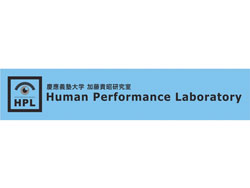 |
 |
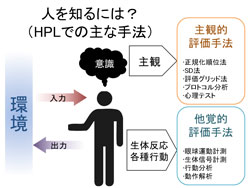 |
| Research contents in HPL (Human Performance Laboratory) |
Evaluation Method to Characterize HPL and Diverse Researches
HPL, which studies various issues about human performance in a wide range of domains from psychological and physical aspects, verifies human activities experimentally by approaches based on sport psychology and ergonomics.
The methods taken there are divided largely into the "subjective evaluation method" and the "objective evaluation method". The former compares and make data on human's subjective views through questionnaires and interviews, and the latter obtain biological reactions and behavior that the subject cannot be conscious of such as eye movements and biological signals as data.
The latter is a concept that Professor Emeritus Tadahiko Fukuda, former teacher of Associate Professor Kato advocated, and also a method to characterizes HPL as a seminar. For example, in representing a situation hard to describe verbally, such as the one in which "the body reacts spontaneously", as often said in sport communities, the viewpoint movements of experts and ordinary people are measured. Effectiveness of discussion on the skills and knacks of experts based on the difference was expected.
Furthermore, since environment concerned with human performance includes a wide range of things and human relations etc., research targets of HPL also range widely from sport to art, business, and human relationship. Among them, great importance is attached on appropriate utilization of above-mentioned kinds of evaluation methods. In particular, reflecting the stance of SFC that attach weight on using cutting-edge ICT, students who take part in HPL are required to freely use the technology for measuring eye movements and biological signals as well as for movement analysis such as motion capture.
Every year about 50 students take part in HPL including several graduate students with undergraduate students from both Faculty as its core. Half of the students belong to athletic clubs such as of baseball, volleyball, figure skating, and automobile driving, aiming at leading the research in HPL to improvement of their own performance.
In January this year, NTT started a sports brain science project of searching
for ways of training brains to support "mind" and "skill"
to win by integrating a research approach of brain science with advanced
ICT. In collaboration between the Baseball clubs of Tokyo University and
Keio University, Associate Professor Kato, who also serves as Deputy director,
Keio University Athletic Association, is leading the endeavor of Keio's
side. Moreover, He cooperated in academic terms with "21_21 DESIGN
SIGHT Exhibition 'ATHLETE'" held from Feb to June this year, supporting
an attempt to connect art and athletes.
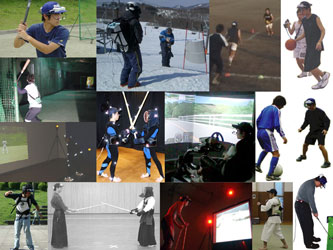
|
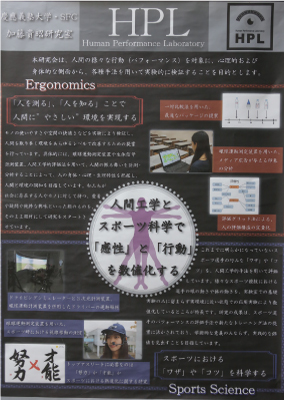 |
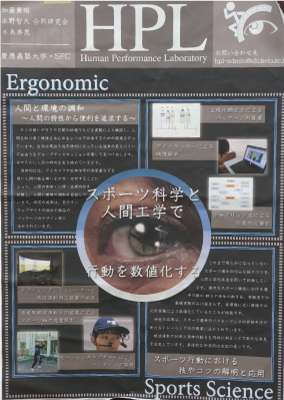 |
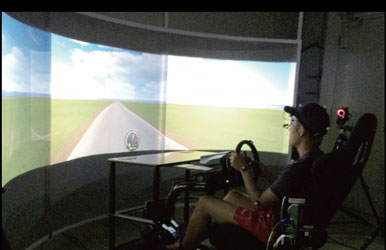 |
| Verifying human behavior by approaches using sport psychology and ergonomics |
Possibilities to Expand Through Linking UC-win/Road DS with Methods Owned by HPL
As mentioned at the beginning, since Associate Professor Kato originally specialized in human performance through sports, he developed the research field into the automobile field by utilizing the methods accumulated in HPL. In that process, there was an increase in needs to build up a simulator environment as close as the reality without spending much cost.
Then a few years ago, they developed a simple simulator by connecting a racing game for PC to a projector. It was difficult to create an original course at that time, so they used data created and published by the users of the game the world over. Consequently, both of the course and vehicle behavior were based on the specifications for racing. Then they were faced with restrictions in simulation, which assumes general vehicles. This made them to search for what realizes the simulator environment usable for experiments and was capable of creating courses as easily as possible.
In the field of drivers, teachers in other universities had already achieved a plenty of results in researches in relation to vision such as eyeball movement since Prof. Kato was a student. Thus, he was thinking that he should not step into the field. However, the actual circumstances were revealed one after another that suggest "all the details may not actually be known." Following that a student who intends to do research on driving joined HPL, research on driving in HPL was embodied. Moreover, it was decided to start a joint study with an external organization to with a focus on the human side during driving, leading the research in this field to get into full swing.
|
They began searching for a DS that satisfied such requirements since about
October 2016, and introduced UC-win/Road DS in November after comparative
investigations over plural systems on some points including easiness of
creating VR spaces and representability with reality. First, students made
experiments to find out the difference between beginner and expert drivers
in "what they see" when traveling on a curve by linking the DS
and measurement of eyeball movement. Giving instructions on VR to allow
the beginners to learn the expertise of expert drivers, they verified what
kind of effects this had, and completed a paper by December. At that time,
they were able to construct the planned experimental environment comparatively
in a short time with the DS, though it had been hard to create a new course
before. In addition, compared with the traditional projector, Associate
Professor Kato felt clear and smooth images of movement on the 4K monitor
used with the DS.
|
 |
| UC-win/Road Drive Simulator using a 4k monitor |
He and others are newly focusing the human side during automated driving.
As an extension of their own researches so far, they currently progressing
discussions such as "what is a human doing in a vehicle (on the stage
a little bit before perfect automated driving)" or "what kind
of reaction a human makes when he or she senses danger".
After that the DS improved its functions including support for acquisition of CAN data. More advanced linking with various experimental equipment owned by HPL attracts attention. Furthermore, extension of new possibilities of utilization can be expected, such as creation of diversified scenario, liaison with subjective evaluation methods, or discussions on human performance through dual task setups etc.
|